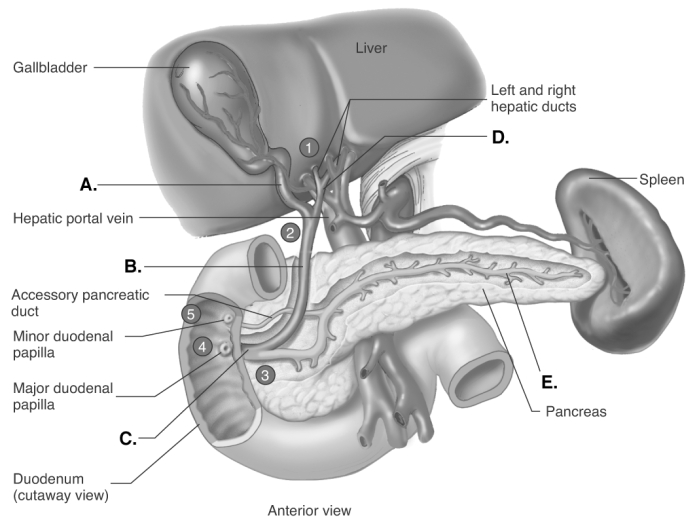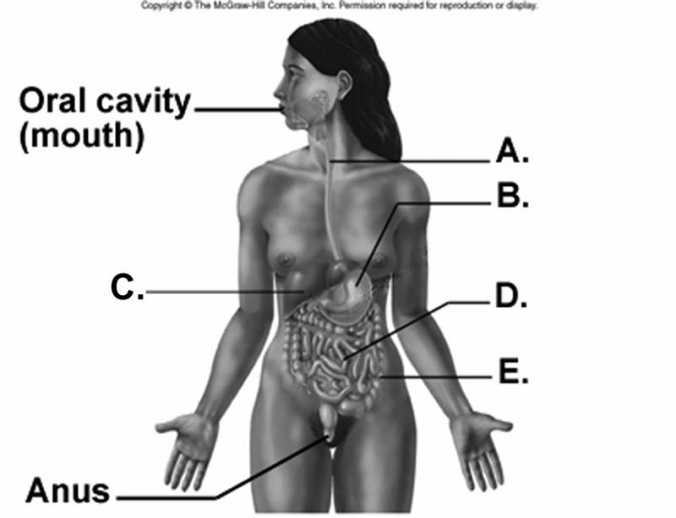A) bile
B) pepsin
C) isomaltose
D) sucrase
E) lipase
Correct Answer

verified
Correct Answer
verified
Multiple Choice
 -The figure illustrates bile drainage. What does "A" represent?
-The figure illustrates bile drainage. What does "A" represent?
A) hepatopancreatic ampulla
B) pancreatic duct
C) common hepatic duct
D) common bile duct
E) cystic duct
Correct Answer

verified
Correct Answer
verified
Multiple Choice
Gastrocolic reflexes are reflexes that
A) empty the stomach.
B) release gastric secretions into the stomach.
C) cause mass movements of the colon when food is present in the stomach.
D) lead to mass movements of the colon in response to food in the duodenum.
E) stop movement in the colon.
Correct Answer

verified
Correct Answer
verified
Multiple Choice
What are the two major neurotransmitters of the ENS in the digestive tract?
A) epinephrine and serotonin
B) epinephrine and norepinephrine
C) acetylcholine and epinephrine
D) norepinephrine and acetylcholine
Correct Answer

verified
Correct Answer
verified
Multiple Choice
Teeth in adults
A) are replaced by osteoblast activity if they are extracted.
B) are distributed so that there is one canine tooth in each half jaw.
C) are all of the same type - molars.
D) are composed of living cells called enamel cells.
E) do not play a role in speech.
Correct Answer

verified
Correct Answer
verified
Multiple Choice
Match the disorder with the best description. -hemorrhoids
A) inflammation of the liver
B) watery feces
C) bad breath
D) enlargement or inflammation of the vein of the anal canal
E) chronic acid in the esophagus
Correct Answer

verified
Correct Answer
verified
Multiple Choice
Match the cell type with its function. -absorptive cells
A) produce hormones
B) produce mucus
C) may protect intestinal epithelium
D) synthesize bile
E) produce digestive enzymes
Correct Answer

verified
Correct Answer
verified
Multiple Choice
Which of the following is true?
A) Peptidases are made in the large intestine.
B) Intestinal epithelial cells absorb more dipeptides and tripeptides than single amino acids.
C) The hepatic artery transports amino acids from the small intestine to the liver.
D) Amino acids leave intestinal epithelial cells and enter the lacteals.
E) Protein digestion starts in the duodenum.
Correct Answer

verified
Correct Answer
verified
Multiple Choice
Which of the following is NOT a muscle of mastication?
A) temporalis
B) masseter
C) medial and lateral pterygoids
D) buccinator
Correct Answer

verified
Correct Answer
verified
Multiple Choice
Match the secretion with the correct cell type. -bile
A) endocrine cells
B) hepatocyte
C) parietal cells
D) acinar cells
E) goblet cells
Correct Answer

verified
Correct Answer
verified
Multiple Choice
 -What does "C" represent on the diagram?
-What does "C" represent on the diagram?
A) small intestine
B) large intestine
C) esophagus
D) stomach
E) liver
Correct Answer

verified
Correct Answer
verified
Multiple Choice
The digestive functions performed by saliva and salivary amylase respectively are
A) flushing and protein digestion.
B) swallowing and fat digestion.
C) peristalsis and polysaccharide digestion.
D) moistening and starch digestion.
E) None of these choices is correct.
Correct Answer

verified
Correct Answer
verified
Multiple Choice
The intestinal phase of gastric secretion
A) is controlled by the entrance of acidic chyme into the duodenum.
B) leads to increased gastric secretion if duodenal pH falls below 2.
C) only stimulates gastric secretion.
D) will decrease gastric secretion when gastrin is released by the duodenum.
E) is controlled by the entrance of alkaline material into the small intestines.
Correct Answer

verified
Correct Answer
verified
Multiple Choice
Pepsinogen
A) is secreted by parietal cells.
B) is activated by salivary amylase in swallowed food.
C) is packaged in zymogen granules.
D) operates optimally at a pH of 5 or more.
E) helps to form peptide bonds.
Correct Answer

verified
Correct Answer
verified
Multiple Choice
The gallbladder contracts in response to the hormone
A) secretin.
B) cholecystokinin.
C) gastrin.
D) somatostatin.
E) insulin.
Correct Answer

verified
Correct Answer
verified
Multiple Choice
Which layer of the small intestine wall contains cells with microvilli?
A) submucosa
B) mucosa
C) muscularis
D) serosa
E) adventitia
Correct Answer

verified
Correct Answer
verified
Multiple Choice
Match the organ with the appropriate function. -gallbladder
A) secretion of saliva
B) manipulation of food
C) swallowing
D) storage of bile
E) protection of small intestinal wall
Correct Answer

verified
Correct Answer
verified
Multiple Choice
Arrange the following in order from largest to smallest: (1) dipeptide (2) protein (3) amino acid (4) polypeptide
A) 3, 1, 4, 2
B) 4, 1, 2, 3
C) 2, 4, 1, 3
D) 1, 2, 3, 4
E) 2, 4, 3, 1
Correct Answer

verified
Correct Answer
verified
Multiple Choice
Match the enzyme with the products of its digestive activity. -carboxypeptidase
A) glucose and galactose
B) amino acids
C) fatty acids and glycerol
D) maltose and isomaltose
E) polysaccharides and disaccharides
Correct Answer

verified
Correct Answer
verified
Multiple Choice
The distention of the stomach by food is the primary stimulus to begin the
A) cephalic phase of gastric secretion.
B) gastric phase of gastric secretion.
C) intestinal phase of gastric secretion.
D) cystic phase of gastric secretion.
E) hepatic phase of gastric secretion.
Correct Answer

verified
Correct Answer
verified
Showing 21 - 40 of 258
Related Exams